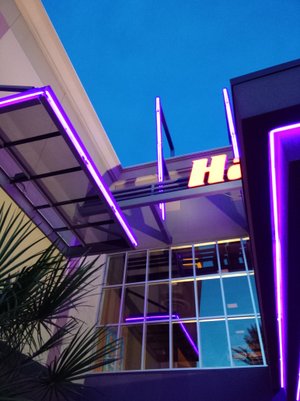Oppo N1 Review: Future-Looking Phablet Or Oversized Flop?
Oppo's N1 sports a unique pivoting camera, a large-format display, and two different operating system options. Are those features enough to make up for an older hardware platform and dicey software optimization in a sea of compelling competition?
Why you can trust Tom's Hardware
Camera: Photo And Video Quality
Still Image Quality
In order to evaluate image quality, I took a variety of pictures under different lighting conditions. All pictures were taken with the native camera app using default or automatic settings.
Pictures from the N1 are compared with those from the iPhone 5s, which contains one of the better smartphone cameras currently available. The iPhone 5s also uses a completely different CMOS with larger pixels, so there should be some notable differences.


In this outdoor, sunlit scene, the iPhone 5s produces an image with vibrant, accurate color. The N1 on the other hand, is overexposed, creating washed-out colors and overly bright whites that overpower fine detail within the flower petals.


In this outdoor scene, both cameras produce an image that is less-than-perfect. The iPhone 5s doesn't set the white balance correctly, giving the picture a yellow tint. Color accuracy is better on the N1. However, it again suffers from an incorrect exposure setting. This time, the image is underexposed, resulting in a darker output. There’s also much more noise overall, especially evident in the blue sky. That noise also obscures fine detail and negates the N1’s resolution advantage. Of the two issues, white balance is the easiest to correct in post-processing, so the iPhone 5s picture is preferred.


Although this dark scene close to sunset would have benefitted from HDR, I left it turned off. Exposure looks good, and even the N1 gets it right. The darker clouds in the iPhone 5s picture have an odd blockiness to them that appears to be the result of an overly aggressive de-noise algorithm. Color and brightness are pretty good with the iPhone also, but the N1 misses on color. There’s not enough yellow from the sun, and the blue sky has an overly dark tone. The larger pixels in the iPhone sensor do a better job capturing light and reducing noise than the additional white pixels in the N1’s CMOS.


The purple neon looks much better reproduced by the iPhone, where individual tubes can be clearly seen. On the N1, the neon appears overexposed, causing it to look overly bright and washing out detail from the tubes.
Apple's iPhone also shows the setting sun's highlight on the building facade to the left. Plants in the foreground also appear brighter and much sharper than they do on the N1. Looking closely at the blue sky shows that noise levels are fairly similar, with the N1 holding a slim advantage. For the building facade on the left, however, the iPhone exhibits far less noise.
Get Tom's Hardware's best news and in-depth reviews, straight to your inbox.


This scene is indoors with an overhead light providing the illumination; the incandescent bulbs naturally produce light with a yellow tint. In the picture taken with the iPhone 5s, the yellow cast is apparent. And that's fairly accurate. The image from the N1, however, shows an unnatural reddish tint. In addition to the false color, the N1 again produces an overly soft, unfocused picture, which is most obvious when looking at the colored balls at the back of the scene. There’s also far more noise present in Oppo’s image, which is very noticeable on the blue book and those balls. The iPhone’s larger pixels win again.


This is the same indoor scene, but with the overhead light turned down low. While neither of these images will ever be framed and hung on a wall, the iPhone 5s picture is clearly superior. Oppo's solution suffers all the same deficiencies: reddish tint, blurry, and excess noise.


And we have the same scene once again, but now each camera’s flash brightens the shot. The "True Tone" dual-LED flash on the iPhone 5s lights an image that’s pleasant to look at. Colors are rich and accurate, there’s almost no noise, and the entire picture is crisp with lots of detail, even showing the subtle pattern of the book cover.
The picture from the N1, while not bad, suffers from poor white balance, giving the image a purple tint. There’s some noise present, but it’s not excessive. The N1, even with its higher resolution, fails to capture the pattern on the blue book cover.
Video
The N1 supports three different video formats: 480p30, 720p30, and 1080p30, all encoded with H.264. Audio is encoded as AAC 48 kHz stereo for all formats. There’s also a slow motion mode, but it’s disappointing. The feature appears to capture at 90 FPS and output at 800x480p30, where most flagship phones capture at 120 FPS and output 1080p30 video. Also, the N1 records its slow motion video without any sound.
The Sony IMX135 sensor provides an HDR movie mode, which records two different exposure settings for each frame, and then combines them via image post-processing. The resulting video is 1080p30-encoded with H.264, and audio is encoded as AAC 48 kHz stereo.
Current page: Camera: Photo And Video Quality
Prev Page Camera: Hardware And Software Next Page Notable Hardware Features-
wavetrex Just a small comment about OLED, even if this might not be the place to write about it.Reply
Probably due to to imperfections in the transistors that control the OLED pixels, there is a very faint but perceptible in deep darkness leakage of energy toward the pixels.
Yes, doesn't compare to the obvious light bleed of any TFT display, but the OLED "off" pixels are not truly off, they have a 0.00something-small level of light which could theoretically be measured by some very sensitive equipment.
The eyes are certainly capable of seeing it... -
InvalidError Putting both flash LEDs on the same side so close to the image sensor seems like a missed opportunity to me: putting one LED close to each hinge with the camera in the middle would provide more even lighting and softer shadows.Reply
With the mostly passable image quality, that would not help the N1 much though. -
Onus Please don't put the letters "p" "h" "a" "b" "l" "e" "t" together in that order and treat it like a word.Reply
-
WyomingKnott @onusReply
First time I read the term I had the image of holding my 10" Asus pad up to my face and talking into it. I suppose it's better than a shoe; cleaner, too. -
shahbaz200 Bad GPU, doesn't works well on this device, poor performance, other than that its good device.Reply -
BlankInsanity please respect my opinion, but I don't see why phones need to go bigger. i the 90s phones used to be huge and this was a problem for mobility and so as the years went by they created smaller form factor phones. Now here we are repeating that mistake. A phone is ment to make a small footprint when hidden on it's user such as a pocket. You don't put your tablet in your pocket, I don't see why'd you make a phone out of it. this is just my opinionReply -
jankeke "please respect my opinion, but I don't see why phones need to go bigger. i the 90s phones used to be huge and this was a problem for mobility and so as the years went by they created smaller form factor phones. Now here we are repeating that mistake. A phone is ment to make a small footprint when hidden on it's user such as a pocket. You don't put your tablet in your pocket, I don't see why'd you make a phone out of it. this is just my opinion "Reply
True but people couldn't watch porn on their phones back then so it made sense to make them as small as possible. Not so now ... ^^ -
Matthew DiGiacomo No offense Tom's Hardware but why are you reviewing this phone now? It's outdated and been on the market for almost 8 months.. No one really cares about it anymore.Reply -
falchard The Camera is a smart solution meaning you won't need 2 cameras. Obviously it will need tilt support to tell it which direction is up.Reply
No removable battery is a shitty solution. Its the issue all phones face after 2 years, their batteries no longer hold a charge. -
BlankInsanity Reply13717317 said:The Camera is a smart solution meaning you won't need 2 cameras. Obviously it will need tilt support to tell it which direction is up.
No removable battery is a shitty solution. Its the issue all phones face after 2 years, their batteries no longer hold a charge.
lol that's a scam the companies do to force you to buy a new one ;)